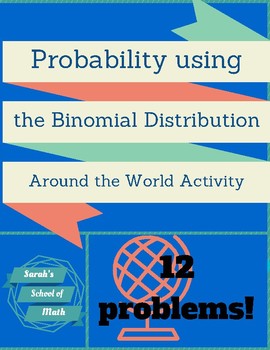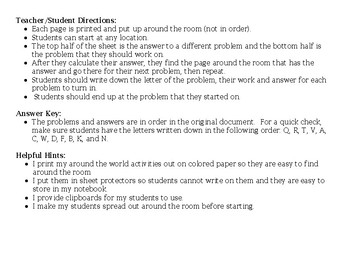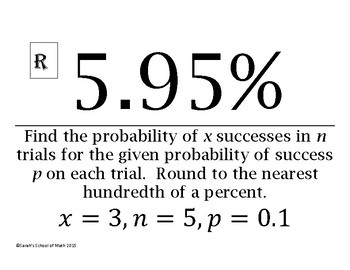Probability using the Binomial Distribution Around the World Activity
Sarah's School of Math
230 Followers
Grade Levels
9th - 12th
Subjects
Resource Type
Standards
CCSSHSS-CP.B.9
CCSSHSS-MD.A.3
Formats Included
- PDF
Pages
14 pages
Sarah's School of Math
230 Followers
Description
This is an around the world activity also known as a scavenger hunt. Students love being able to get out of their desks and move around the room! There are a total of 12 problems that require the students to calculate the probability of an event given the number of trials, the number of successes, and the probability of success. There are 4 word problems and 8 problems where x, n, and p are explicitly given. I also have a product that is all word problems. Check out the link below.
How the Activity Works:
•Each page is printed and put up around the room (not in order).
•Students can start at any location.
•The top half of the sheet is the answer to a different problem and the bottom half is the problem that they should work on.
•After they calculate their answer, they find the page around the room that has the answer and go there for their next problem, then repeat.
•Students should write down their work and answer for each problem to turn in.
•Students should end up at the problem that they started on.
Looking for other resources on probability? Check out:
Binomial Probability Around the World Activity-all word problems
Normal Distributions Station Activity: 10 stations!
Basic Probability Matho Game-Includes the addition rule!
Combinations and Permutations Around the World Activity
Probability Quiz Review (FCP, Permutations and Combinations, Mult/Add Rules)
Probability Test (Perm/Comb, Mult/Add Rules, Binomial expansions and prob.)
Conditional Probability Around the World Activity (scavenger hunt)
Basic Probability Class Survey
How the Activity Works:
•Each page is printed and put up around the room (not in order).
•Students can start at any location.
•The top half of the sheet is the answer to a different problem and the bottom half is the problem that they should work on.
•After they calculate their answer, they find the page around the room that has the answer and go there for their next problem, then repeat.
•Students should write down their work and answer for each problem to turn in.
•Students should end up at the problem that they started on.
Looking for other resources on probability? Check out:
Binomial Probability Around the World Activity-all word problems
Normal Distributions Station Activity: 10 stations!
Basic Probability Matho Game-Includes the addition rule!
Combinations and Permutations Around the World Activity
Probability Quiz Review (FCP, Permutations and Combinations, Mult/Add Rules)
Probability Test (Perm/Comb, Mult/Add Rules, Binomial expansions and prob.)
Conditional Probability Around the World Activity (scavenger hunt)
Basic Probability Class Survey
Total Pages
14 pages
Answer Key
Included
Teaching Duration
1 hour
Report this resource to TPT
Reported resources will be reviewed by our team. Report this resource to let us know if this resource violates TPT’s content guidelines.
Standards
to see state-specific standards (only available in the US).
CCSSHSS-CP.B.9
Use permutations and combinations to compute probabilities of compound events and solve problems.
CCSSHSS-MD.A.3
Develop a probability distribution for a random variable defined for a sample space in which theoretical probabilities can be calculated; find the expected value. For example, find the theoretical probability distribution for the number of correct answers obtained by guessing on all five questions of a multiple-choice test where each question has four choices, and find the expected grade under various grading schemes.





